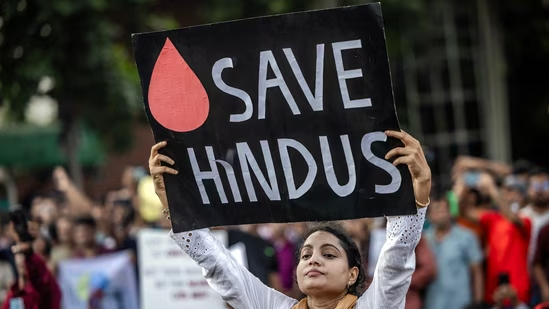Introduction
As the world advances into an era of unprecedented connectivity and awareness, the notion of human rights has become central to global discourse. Yet, in stark contradiction to this ideal, certain atrocities continue to unfold with little to no international attention. One such crisis is the systematic persecution and genocide of Hindus in Bangladesh. Despite the severity and scale of the violence against this religious minority, the global community remains largely silent. This blog seeks to explore the historical context, current situation, and reasons behind this alarming indifference. While calling for immediate and effective action.
The plight of Hindus in Bangladesh is not a recent development but a deeply rooted issue that dates back to the tumultuous period of the Indian subcontinent’s partition in 1947. Over the decades. The Hindu population in Bangladesh has faced waves of violence, discrimination, and displacement. Reducing their numbers from approximately 22% of the population at the time of partition to less than 8% today. This demographic shift is not a natural occurrence but the result of continuous and often state-sanctioned persecution.
In this extensive analysis. We will delve into the history that laid the groundwork for this persecution. Examine the various forms of violence and discrimination that Hindus in Bangladesh endure, and scrutinize the international community’s failure to address this genocide. The goal is not only to raise awareness but also to spark action, for the time to act is now.

Historical Context
The roots of the persecution of Hindus in Bangladesh traced back to the partition of British India in 1947. The partition intended to create separate states for Hindus and Muslims, resulted in the creation of India and Pakistan. Pakistan divided into two geographically separated regions: West Pakistan (modern-day Pakistan) and East Pakistan (modern-day Bangladesh). The partition marked by one of the largest mass migrations in human history, with millions of Hindus, Muslims, and Sikhs moving across the newly drawn borders in search of safety. This migration was accompanied by widespread communal violence, which left deep scars on the psyche of the subcontinent’s populations.
In East Pakistan, Hindus found themselves a minority in a predominantly Muslim country. From the outset, they faced discrimination and violence. The Pakistani state, dominated by West Pakistan, viewed Hindus with suspicion, often considering them as sympathizers of India. This mistrust was institutionalized through policies that marginalized Hindus economically, politically, and socially.
The situation took a turn for the worse during the Bangladesh Liberation War of 1971. The war, which led to the independence of Bangladesh from Pakistan, was one of the bloodiest conflicts in modern history. The Pakistani military, in its attempt to suppress the independence movement, unleashed a campaign of mass violence that targeted Hindus in particular. It is estimated that hundreds of thousands of Hindus killed, and many more displaced during this period. Although Bangladesh emerged as an independent nation in 1971, the Hindu population continued to face persecution.
Post-independence, the situation for Hindus in Bangladesh did not improve significantly. Successive governments, whether military or civilian, have failed to protect the rights of Hindus. The state machinery has often been complicit in or indifferent to the violence against Hindus. This has resulted in a continuous exodus of Hindus from Bangladesh, with many seeking refuge in India and other countries.

The Nature of the Persecution
The persecution of Hindus in Bangladesh manifests in various forms, ranging from physical violence to cultural and religious erasure. The violence against Hindus is not random but often orchestrated by organized groups, sometimes with the tacit support of the state. The following are some of the key forms of persecution faced by Hindus in Bangladesh:
1. Physical Violence and Atrocities: Hindus in Bangladesh frequently subjected to mob violence, which includes beatings, killings, and rapes. These acts of violence often perpetrated with impunity, as the perpetrators face little to no legal consequences. There have been numerous instances where Hindu homes and businesses attacked, looted, and burned down, often in response to false accusations of blasphemy or other provocations.
2. Forced Conversions and Marriages: Hindu women and girls are particularly vulnerable to forced conversions to Islam. Many are abducted, forcibly converted, and married off to Muslim men against their will. These acts are not only a violation of individual rights but also serve as a tool of religious and cultural domination.
3. State-Sponsored Discrimination: The Bangladeshi state has enacted laws and policies that discriminate against Hindus. Particularly in matters of property and land ownership. The Vested Property Act, for example, allows the government to confiscate property from individuals it deems to be “enemies of the state,”. A provision that has been disproportionately applied to Hindus.
4. Cultural and Religious Erasure: The destruction of Hindu temples and religious sites is a common occurrence in Bangladesh. These acts of vandalism are often aimed at erasing the cultural and religious identity of Hindus. In many cases, the state has failed to protect these sites or to hold those responsible accountable.
5. Demographic Decline: The Hindu population in Bangladesh has been steadily declining due to the continuous persecution and violence. This demographic decline is not only a result of forced migration but also of lower birth rates among Hindus, who face economic and social marginalization.
International Response and Global Silence
One of the most troubling aspects of the persecution of Hindus in Bangladesh is the lack of international attention and response. Despite the severity of the situation, the global community has largely remained silent. There are several factors that contribute to this silence:
1. Lack of Media Coverage: The mainstream media has largely ignored the plight of Hindus in Bangladesh. This lack of coverage is due in part to the complex nature of the conflict and the challenges of reporting from the region. However, it also reflects a broader tendency to overlook issues that do not fit into the dominant narratives of global politics.
2. Role of International Organizations: International organizations, including the United Nations, have been slow to respond to the situation in Bangladesh. While there have been some reports and statements condemning the violence, these have not translated into meaningful action. The lack of a coordinated international response has allowed the persecution to continue unchecked.
3. Geopolitical Interests: The geopolitical dynamics of South Asia play a significant role in the global silence on the persecution of Hindus in Bangladesh. Many countries, including those in the West, have strategic interests in maintaining good relations with Bangladesh. Which may explain their reluctance to criticize the government or take action on behalf of the Hindu minority.
4. Comparisons to Other Global Crises: The persecution of Hindus in Bangladesh is often overshadowed by other global crises that receive more attention and resources. The lack of a strong advocacy movement for Hindus in Bangladesh has also contributed to the issue being overlooked.
The Impact on the Hindu Community
The impact of the persecution on the Hindu community in Bangladesh is profound and multifaceted. The violence and discrimination have not only led to a demographic decline but have also had severe psychological, social, and economic consequences.
1. Psychological and Social Impact: The continuous threat of violence has created a climate of fear and insecurity among Hindus in Bangladesh. Many Hindus live in constant fear of being targeted. And this has led to a sense of isolation and alienation from the broader society. The trauma experienced by survivors of violence, particularly women and children. Is often long-lasting and difficult to address due to the lack of support services.
2. Economic Marginalization: The persecution of Hindus has also had significant economic consequences. Many Hindus have been forced to flee their homes and abandon their livelihoods, leading to increased poverty and economic marginalization. The confiscation of land and property under discriminatory laws has further exacerbated the economic hardships faced by Hindus in Bangladesh.
3. Impact on Women and Children: Hindu women and children are among the most vulnerable to violence and discrimination in Bangladesh. Forced conversions, abductions, and sexual violence are common. And the lack of legal protection and recourse means that perpetrators often go unpunished. The impact on children is particularly severe. As many are forced to drop out of school or face discrimination in educational institutions.
4. Diaspora Responses: The global Hindu diaspora has been increasingly vocal about the persecution of Hindus in Bangladesh. Diaspora organizations have been working to raise awareness and provide support to those affected. However, the efforts of the diaspora are often hampered by the lack of international attention and the challenges of mobilizing resources for a cause that is not widely recognized.
Calls to Action
Given the gravity of the situation, it is imperative that the international community takes immediate action to address the persecution of Hindus in Bangladesh. The following are some steps that can be taken:
1. Role of the International Community: Governments and international organizations must recognize the persecution of Hindus in Bangladesh as a serious human rights issue and take concrete steps to address it. This includes applying diplomatic pressure on the Bangladeshi government to protect the rights of its Hindu minority and hold perpetrators of violence accountable.
2. Media Advocacy: Raising awareness through the media is crucial to bringing attention to the plight of Hindus in Bangladesh. Journalists, activists, and human rights organizations must work together to ensure that the issue receives the coverage it deserves. Social media can also play a significant role in mobilizing public opinion and advocating for change.
3. Legal and Diplomatic Pressure: International legal frameworks, such as those provided by the International Criminal Court and the United Nations, should be utilized to hold those responsible for the persecution accountable. Diplomatic efforts should also be made to encourage the Bangladeshi government to repeal discriminatory laws and policies that target Hindus.
4. Support for Victims: Humanitarian organizations should provide support to victims of violence and discrimination, including legal aid, psychological counseling, and economic assistance. The international community should also work to ensure that refugees and displaced persons receive adequate protection and support.
Conclusion
The persecution of Hindus in Bangladesh is a grave injustice that has persisted for far too long. The global silence on this issue is not only a moral failure but also a reflection of the broader challenges in addressing human rights violations in regions that do not receive sufficient attention. The time has come for the international community to break its silence and take decisive action to protect the rights and lives of Hindus in Bangladesh.
The question remains: Where are the eyes of the world? The answer lies in our collective will to recognize and act upon the atrocities being committed. It is only through awareness, advocacy, and concerted effort that we can hope to bring an end to the persecution and ensure that the rights of all people, regardless of their religion, are respected and protected.







